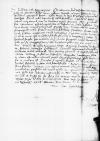⌊⌋ mihi pergratae fuere. Quod de rebus tuis scire desideras orig. desyderas⌈desiderasdesideras orig. desyderas⌉, ita habe. Heri ita permotum fuisse hunc nostrum ⌊Nestorem⌋ ob nova Italica, ut non admodum opportunum fuerit. Dedi tamen et legit, sed postquam aliquamdiu habuisset. Demum nihil locutus orig. loquutus⌈locutuslocutus orig. loquutus⌉ est, nisi ad scribendum inhabilem esse, postea curaturum, neque tempus erat, ut admodum urgerem. Permovet ⌊illum⌋, quod nuntiatum orig. nunciatum⌈nuntiatumnuntiatum orig. nunciatum⌉ fuit ⌊Germanos pedites⌋ capitali odio cum ⌊Hispanis⌋ in ⌊Italia⌋ dissidere eaque ex re timeri maiorem calamitatem.
⌊Pontifex maximus⌋ ⌊viceregi⌋ obtulit centum quinquaginta[1] milia scutorum aureorum, si decederet, Florentini privato nomine ita, ut publica auctoritas orig. authoritas⌈auctoritasauctoritas orig. authoritas⌉ nondum intercesserit, ducentena milia ducatorum, sic tamen, ut ⌊civitas ipsa⌋ in ⌊caesaris⌋ fide sit servanda a direptione. ⌊Vicerex⌋ ad ⌊Borbonium⌋ scripsit pro mittendo ad se cambio sexaginta milium ducatorum, quod ipse sit ⌊Genuae⌋ persoluturus.
De direptione ⌊Placentiae⌋ hic nihil auditum. Praesidet orig. Presidet⌈PraesidetPraesidet orig. Presidet⌉ illi ⌊Guido Rangonus⌋ comes, ut ⌊Parmae⌋ Franciscus de Bozulo[2] et ⌊Bononiae⌋ ⌊Marchio Salutiarum⌋.
Coniuratio ⌊Germanorum⌋ adversus ⌊Mediceos⌋ nondum audita est. ⌊Dux Ferrariae⌋ plurimum ab hostibus sollicitatur, oblata ⌊Modona⌋[3] et ⌊filio uni⌋ desponsanda ⌊magnifici Laurenzini⌋[4] ⌊filia⌋ et ⌊altero⌋ assumendo in numerum ⌊patrum ordinis superlativi⌋. Quid facturus sit, in ambiguo est. Id constat, si annisus fuisset, iam a mensibus duobus ⌊Bononiam⌋ in potestate nostra futuram fuisse.
Nos venturi sumus feria secunda. Interea me tibi, uti parenti, commendo. Rebus tuis curandis ita persuade, tibi omnem operam me impensurum esse. Commenda me reverendo domino ⌊electo Constantiensi⌋ et illustri ⌊domino comiti⌋, et ⌊Melchiori⌋ nostro, et ⌊fratri tuo⌋. Et bezo las manos mas de quarante mille vezes de toda la compaignia.
Bene vale.


 AAWO, AB, D.3, f. 11v
AAWO, AB, D.3, f. 11v